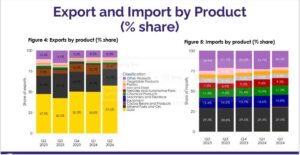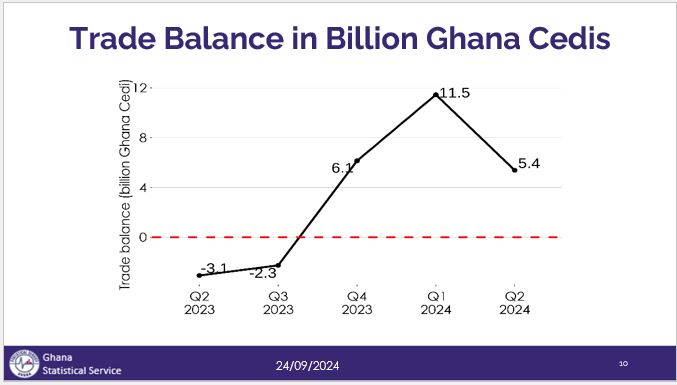By Juliet ETEFE ([email protected])
The economy recorded a trade surplus of GHȼ5.4billion in the second quarter (Q2) 2024, marking the third consecutive excess since the last quarter of 2023, the Ghana Statistical Services (GSS) has said.
The country, however, experienced a 53.04 percent decline in the surplus for Q2, compared to the GHȼ11.5billion recorded in the previous quarter (Q1).
“In Q2 2024, Ghana’s total trade value was GHȼ123billion, with exports totalling GHȼ64.2billion and imports totalling GHȼ58.8billion.
“The country recorded a trade surplus of GHȼ5.4billion, marking a substantial reversal from a deficit of GHȼ3.1billion recorded in the same period in 2023,” government statistician Prof. Samuel Kobina Annim noted while presenting the second quarter trade statistics in Accra.

Export and import by products
Prof. Annim added that gold led the country’s exports with a value of GHȼ37billion, accounting for 57.6 percent of total exports.
The export share of gold is, however, an increase from 47.5 percent in Q2 2023. In contrast, the share of cocoa beans and products decreased from 9 to 6.1 percent over the same period.

Other major exports included crude petroleum representing a value of GHȼ12.6billion and cashew nuts representing GHȼ1.2billion.
Ghana’s import market was predominated by gas oil (GHȼ7.3billion) and motor spirit super (GHȼ7.2billion), which together contributed a quarter – 24.7 percent – of the total import value of GHȼ58.8billion.

Export and import destinations
Prof. Annim also noted that Asia remains Ghana’s leading trade partner, contributing over half of the country’s imports and nearly half of its exports in Q2 2024.
Between the Q2 of 2023 and Q2 2024, the share of imports from Europe declined by 7.5 percent, while imports from Asia increased substantially by 8.5 percent.
China remained the primary source of Ghana’s imports, contributing GHȼ12.3billion – 20.9 percent of total imports, followed by the United Arab Emirates (UAE) with a value of GHȼ9.1billion (15.4 percent) and the United Kingdom with an import value of GHȼ5.2billion –8.8 percent.
“More than a fifth of Ghana’s import comes from China. This pattern has been consistent since 2021, with the exception of the first quarter of 2023.
“For five out of the ten product classifications, the leading country of origin is China. Vegetable products are mainly imported from Vietnam,” he said.
Meanwhile, the UAE remained Ghana’s top export destination, accounting for GHȼ15billion, representing 23.3 percent of total exports.
Switzerland followed closely with exports valued at GHȼ13.2billion, representing 20.5 percent while South Africa ranked third, with exports amounting GHȼ 8.3billion – 12.9 percent.
He added that in Q2 2024, the United Arab Emirates surpassed the United Kingdom as the leading source of mineral fuels and oil.
“Asia and Europe are consistently Ghana’s main export destinations, accounting for 73.9 percent of exports in Q2 2024. Asia remains the main export destination since overtaking Europe Q4 2023.
“There’s a declining trend in the share of imports from Europe in contrast to a rising share from Asia, signalling a significant shift in Ghana’s import sources,” he said.
Export and import unit value indices
The government statistician indicated that the export and import unit value indices (UVIs) revealed price shifts in key commodities, and that export prices recorded a 40.5 percent year-on-year increase, driven largely by surging gold prices while import prices increased by 18.9 percent.
The export and import unit value indices (UVIs) measure the relative price of exported and imported products over time and are used to deflate trade figures from nominal to real values.










